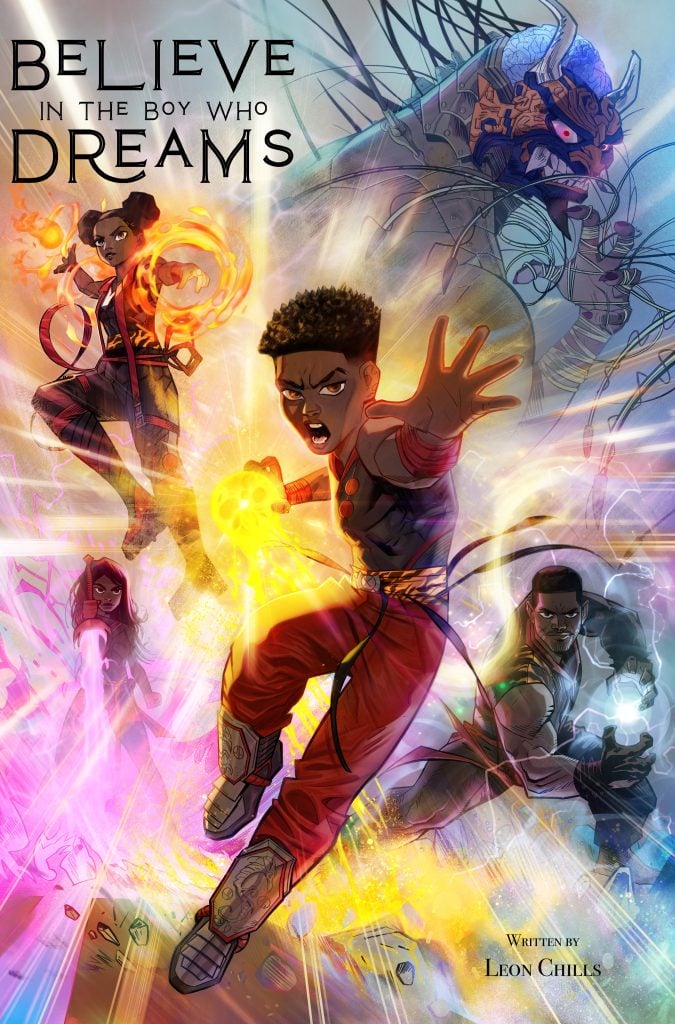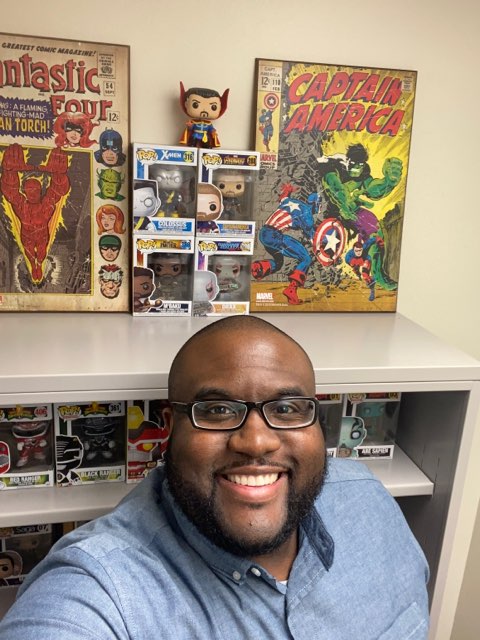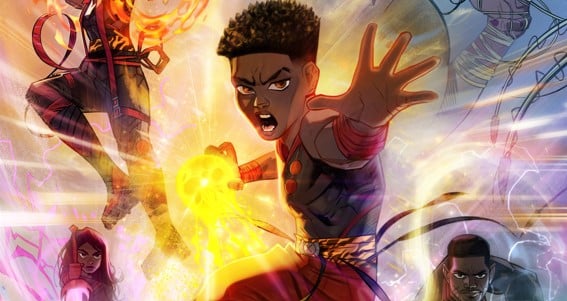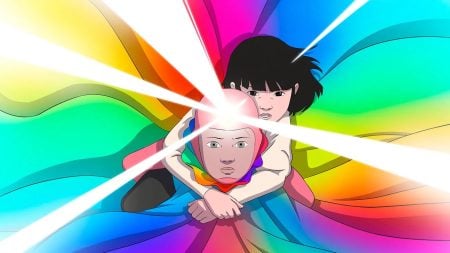Screenwriter Leon Chills (Shadow Force) is no stranger to telling stories that blend genre spectacle with grounded emotional stakes. His latest project, Believe in the Boy Who Dreams, aims to do just that—through the lens of anime. Instead of waiting for Hollywood’s greenlight, Chills has taken a grassroots approach, releasing the script directly to readers and making his case to audiences himself.
We caught up with Leon to talk about the origins of the project, why family remains at the core of his storytelling, and how he’s using unconventional strategies to bring Believe in the Boy Who Dreams to life.
The Origin of Believe in the Boy Who Dreams
GVN: Thank you for returning to Geek Vibes Nation to talk about your script and grassroots campaign for Believe in the Boy Who Dreams. Could you start by telling our audience about the origin of this idea and how it has evolved over the years?
Leon Chills: I wrote the first draft a few years ago. At first, I imagined it as live-action, something like The Matrix. That movie leaned on anime influences without being a direct adaptation, and I wanted to do the same. Eventually, though, I realized the story needed anime in it. For a while, it was even half live-action, half anime.
From Hybrid to Full Anime
GVN: What led to it becoming a full anime film?
Leon Chills: Originally, the “real world” would be live-action, and DJ’s mind would be anime. But then Demon Slayer came out and made $600 million worldwide. That showed me—and hopefully Hollywood—that anime can succeed on its own and still be a global hit.
The hybrid idea was me trying to make it more palatable for decision-makers who didn’t fully understand anime. But now, I feel confident telling the story the way it deserves to be told.
“Now that anime is breaking box office records, I don’t have to split the difference anymore. I can make this project the way it needs to be made.”
Family at the Core
GVN: One thing I really enjoyed about this story is that, at its core, it’s about family. How did you come up with the Garretts, and how do they differ from the family in Shadow Force?
Leon Chills: I wrote Shadow Force before I had kids—it reflected my fears about becoming a parent. The difference with Believe in the Boy Who Dreams is that it was written after becoming a parent. So it has more of my real life experiences in it. That’s why the Garretts start with more tension and dysfunction.
The stress of sleepless nights with a newborn inspired DJ’s conflict. His nightmares keep the family up, creating stress. Being a parent now, I also understand how deeply our choices affect kids, both now and in the future.
There’s no perfect way to parent. But if we can prevent emotional gaps in our children, we can help create a better world.
The literal last name of Garrett is in honor of the best friend I ever had in Christen Evan Garrett. He was killed in a car accident at the age of 19. We bonded over nerd stuff like FF7 and anime growing up.

Character Arcs and Therapy
GVN: Although DJ is the central figure, his parents and sister have their own arcs too. How did you develop those?
Leon Chills: I believe the best way we show up for family is by working on ourselves first. In shonen anime, there’s almost always a training arc. For this story, I wanted the Garrett family to have both the traditional physical training, as well as each one of them having their own psychological training as well, so they can be there for DJ in ways that go beyond just fighting monsters for him. It’s almost like they go through workouts, but then go to therapy as well.
GVN: I’m glad you mentioned therapy, because it’s still taboo in the African American community. Why was it important to include that theme?
Leon Chills: I just wanted to show the family was open to doing whatever they could to help DJ find happiness again. I feel like I’m someone who actively pursues being happy, so in moments where I’m not, I seek out how to get back there. Like how I was happy at JP Morgan in the beginning, because I just felt lucky to have a job, but once that happiness faded, I quit to pursue this dream of screenwriting. And even though I was making less money when I first got to LA, I was happier – which let me know I was on the right path. Similarly, unhappiness came again during the pandemic, so I tried therapy for the first time. Once I felt like I was good again, I stopped. It can be an effective tool if it works for you. So why not try it out.
You mentioned it being taboo, and how your grandmother said go to church instead of therapy. I think you can have both. It doesn’t necessarily have to be one or the other.
Building Mercy Strike
GVN: Let’s talk about the anime world within the script, Mercy Strike. How did you build it?
Leon Chills: There’s two worlds at play, the world of the family, and the world of Mercy Strike. In earlier drafts only the world of the family was built out. At that point, the world of DJ’s mind was called “Japanda” , a mix of Wakanda and Japan lol. Later when I revisited the script, it gave me an opportunity to solely focus on what the world of DJ’s favorite anime would actually be. So I pulled in elements from shows I grew up on—Dragon Ball Z, Yu Yu Hakusho, Bleach—and blended them with my own ideas.
The Obsessed Spirits, for example, came from the idea of humans becoming so obsessed with something – whether it be money, gluttony, etc – that it turns them into literal monsters – hiding behind masks. Hikaru, the family’s mentor, wasn’t in the first draft, but he added a great dynamic. The thought was that if it were me at 12, having nightmares about villains from an anime, then it would have 100% been Goku as the one training my family how to fight.
“Worldbuilding took the script to the next level. It made Mercy Strike feel like a place audiences could truly live in.”

Personal Connections
GVN: Did you put pieces of yourself or your family into the Garretts?
Leon Chills: Definitely. Early on, my big sister and I didn’t get along when we were little kids – like most siblings at that age. I would use the dial-up to play video games online, which would cut off whatever call she was on with her friends lol. But by the time I was in high school and she was in college, we became close. I took a trip to visit her while she was there and it changed everything. Now we’re best friends. That sibling dynamic definitely influenced DJ and his sister Zora in the script.
The parents reflect my wife and I—first-time parents figuring it all out. This story is part childhood memory, part present-day parenthood.
Grassroots Campaign
GVN: You’ve been building buzz for this script through grassroots methods, like releasing it directly to readers. Why take this route?
Leon Chills: There’s a lot of reasons. I care so passionately about this script that I can’t live with just letting it die in the inboxes of producers and executives who may be too afraid to do anything with it. There is a lot of conversation on why we don’t get certain kinds of Black movies and I have to say that it’s not for lack of trying. There are a lot of other Black writers like me doing their best to get projects through, but they never get the greenlight. And we usually just have to suffer in silence about them when we take that traditional path, with people never getting to see that work. For this one, no matter what happens, I at least want people to know that I tried.
I want to establish a direct relationship with the audience. That feels important after the strikes and contraction. Studios and networks can decide at any point to turn the faucet off and stop buying projects, and when that happens, I need to still be able to go directly to the audience myself. For Believe in the Boy Who Dreams, people can subscribe to my site, read the script, and follow along on the journey. Maybe for the next script it’s a paid subscription. Who knows.
I’ve written 14 scripts at this point, but the audience only has the one that’s been produced to judge me off of. And that was a co-writing credit. Even with the comic books I’ve written for, I was co-writing. This is an opportunity to put something out that’s just me. Screenwriting is my art—so I wanted to share it directly.
It’s new. I’ve never seen anyone else do it. So yeah—I’m nervous, but also excited.
Promotion and Strategy
GVN: What other strategies are you using to get the word out?
Leon Chills: I’m pitching it on Instagram all week, showing executives and producers exactly why this project makes sense. Half of Gen Z watches anime. Demon Slayer broke records. K-Pop Demon Hunters became Netflix’s most-streamed film. Ne Zha 2 grossed over $2 billion worldwide.
I’m making the case plainly: this works creatively and financially. Social media is the tool creators have to state our case.
Tropes and Sequels
GVN: Were there any anime tropes you wanted to include but couldn’t?
Leon Chills: I included the ones I wanted. The film pulls mostly from shonen anime, but of course there are lots of other styles. If there were a sequel, I think it would be Believe in the Girl Who Dreams, centered on Zora, the sister. That would probably lean into a different subgenre.
Leon Chills is reimagining what it means to be a screenwriter in Hollywood—by going directly to audiences, embracing anime as a storytelling vehicle, and grounding his work in the universal themes of family and self-growth. With Believe in the Boy Who Dreams, he’s not just pitching a film; he’s inviting viewers to join him on a new kind of creative journey.
The film’s script will be available at www.believeintheBoywhodreams.com on Friday, October 17th.

Writer. Video Essayist. Film/TV Critic. Pop Culture Enthusiast.
When he isn’t writing for Geek Vibes Nation or The Cinema Spot, Tristian can be found typing away at one of the novels or screenplays he’s been working on forever.




![‘Jay Kelly’ Review – Noah Baumbach Makes A Case For The Magic Of Movie Stardom [NYFF 2025] ‘Jay Kelly’ Review – Noah Baumbach Makes A Case For The Magic Of Movie Stardom [NYFF 2025]](https://cdn.geekvibesnation.com/wp-media-folder-geek-vibes-nation/wp-content/uploads/2025/11/Jay-Kelly-JKELLY_20240523_15320_C2_R-300x180.jpg)

